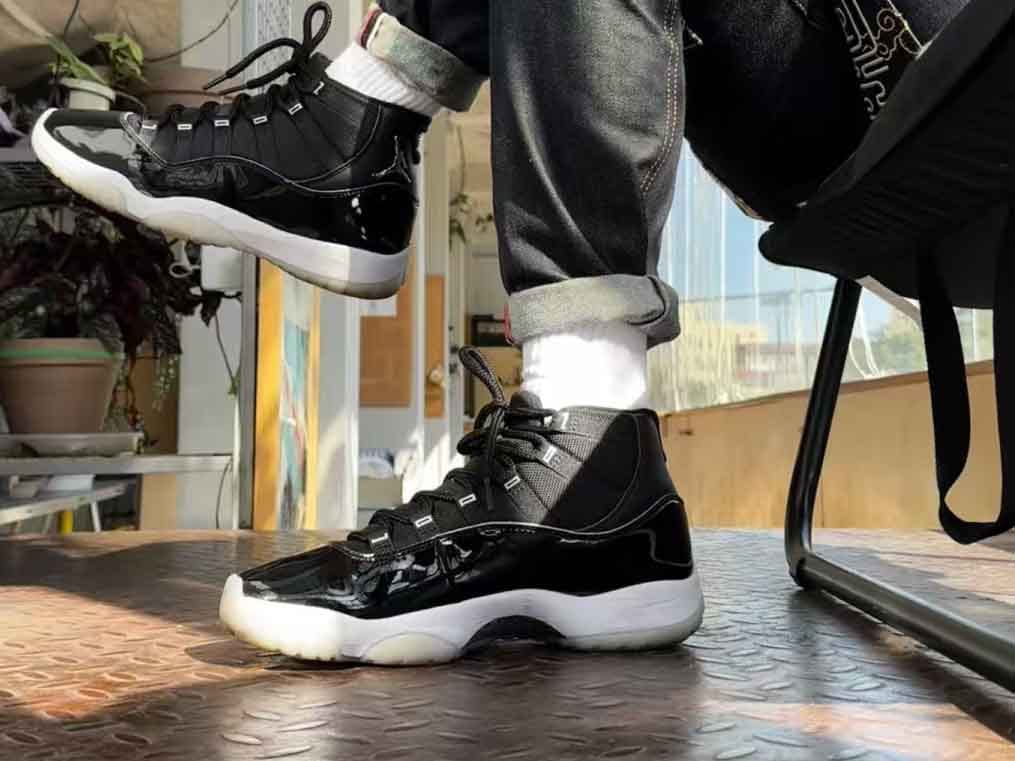Fake Jordan 11 Shoes
“Fake Jordan 11 shoes” usually refer to counterfeit Air Jordan 11 sneakers. There are many fake and shoddy Jordan 11 shoes on the market, which have many differences from the genuine ones in appearance, material, workmanship, etc. Here are some ways to identify fake Jordan 11 shoes:
1. Shoe box:
Printing information: The Nike logo, Jordan logo, etc. on the genuine shoe box are printed clearly and exquisitely, with bright and uniform colors, without blurring, fading or ghosting. For example, the edge lines of the logo should be sharp and clear, while the printing of fake shoe boxes may be rough, the color is dim, and the details of the logo are easily blurred.
Label content: The label on the side of the shoe box should contain detailed shoe information, such as the style name, size, color combination, country/region of manufacture, etc., and the text should be neatly laid out, the font size should be consistent, and there should be no typos. The label of the fake shoe box may have incomplete information, chaotic layout or spelling errors.
2. Shoe appearance:
Overall shape: The overall lines of the genuine Jordan 11 shoes are smooth, the shoe shape is full, and the proportions are coordinated. For example, the toe is rounded and will not be deformed, twisted or collapsed; the curvature of the shoe body is natural, and the transition between the shoe body and the sole is smooth. Fake shoes may be out of shape, with unsmooth lines and an unnatural overall look due to insufficient mold precision or rough production process.
Material texture:
Leather part: Genuine products usually use high-quality leather, which is soft and smooth, has a certain glossiness, and has clear and natural textures. The leather material of fake shoes may be poor, rough and hard, with unnatural glossiness, and the texture may not be clear or too regular.
Patent leather part: The patent leather part of Jordan 11 shoes should be bright, flat and uniform in color. The patent leather of fake shoes may have problems such as uneven color, bubbles, scratches or wrinkles, and the texture of the patent leather may be quite different from that of the genuine product.
Sole part: The rubber texture of the genuine sole is tough, elastic, with clear and deep textures, and the transparent sole part can see the structure and details inside. The rubber of the sole of fake shoes may be harder or softer, with poor elasticity and blurred lines. The transparent sole part may not be able to see the internal structure clearly. Even the sole color of some fake shoes may be significantly different from that of the genuine ones.
Color matching details: Jordan 11 shoes have a variety of classic colors, and the colors of the genuine ones are coordinated and bright. The color matching of fake shoes may have color difference, the color is too bright or dim, or the color transition is unnatural. For example, the black and red Jordan 11, the red of the genuine one is bright and layered, and the black part is pure; the red of fake shoes may be orange or purple, and the black part may be gray.
Embroidery logo: The flying man logo on the tongue, the number 23 on the back of the upper and other embroidery parts, the genuine ones have fine embroidery craftsmanship, neat and tight stitches, smooth lines, full patterns, bright and uniform colors. The embroidery of fake shoes may have problems such as loose stitches, skipped stitches, missing threads, deformed patterns or uneven colors. For example, the outline of the flying man logo may be unclear, the line thickness may be inconsistent, or the embroidery of some parts may be missing.
3. Shoe labels:
Font layout: The fonts on genuine shoe labels are clear and standardized, and the font size, spacing and position have strict standards. For example, the strokes of the font are uniform in thickness, without blurring or sticking; the spacing between numbers and letters is moderate and neatly arranged. The fonts on fake shoe labels may be different from the genuine ones, such as font deformation, uneven stroke thickness, unreasonable spacing, etc.
Information content: The shoe label should contain information such as shoe size, production date, and place of origin. This information should be consistent with the label on the shoe box and the actual situation of the shoe itself. At the same time, pay attention to check whether this information is clear and readable, and whether there are any traces of alteration or blur.
4. Insoles:
Material and craftsmanship: The material of genuine insoles is soft and elastic, the surface fabric texture is clear, the workmanship is fine, and the edges are neat. The printed pattern on the insole is clear and firm, and it will not fade or blur easily. The material of fake insoles may be harder and less elastic, the fabric texture is fuzzy, the workmanship is rough, the edges may have burrs or uneven cutting, and the printed pattern is also easy to fade or blur.
Glue marks on the back: Genuine insoles usually have even glue marks on the back, which is to firmly stick the insoles to the soles. Fake insoles may have uneven, excessive or too few glue marks on the back, and some fake insoles may even have no glue marks.
5. Carbon plate on the sole: The carbon plate on the sole of genuine Jordan 11 shoes is hard, has a certain thickness and toughness, a smooth surface, and uniform color. Press the carbon plate with your fingers and you can feel the obvious hardness and support. The carbon plate of fake shoes may be made of different materials, such as plastic or other inferior materials, and the surface may have flaws, scratches or uneven colors. It feels soft when pressed and does not have enough support.
6. Shoe box stamp: Genuine shoe boxes usually have stamps, and the stamps are clear, consistent in depth, and accurate in position. The stamps on fake shoe boxes may be blurred, inconsistent in depth, or offset.

